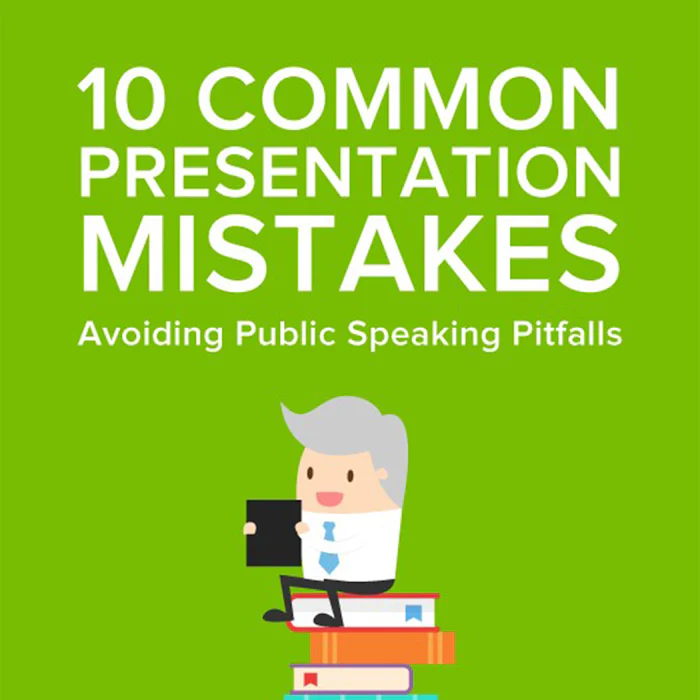
Here’s an assignment with a high degree of difficulty: give a presentation about how to present.
I’d tackle this challenge by starting with an exercise that involves the audience right away. For example, ask participants to share the worst presentation habits they’ve encountered.
This not only warms up those in attendance, it sets the stage for the content you’ll share.
And, along the way, you’ll get a whole host of techniques you shouldn’t do. Here are 15 mistakes presenters make. You may know most of these, but it’s worth a reminder that you should never:
- Forget that you’re up there not to promote how wonderful you are, but to provide value to the audience.
- Lose focus of what the audience needs from you. One way: Before you start talking, ask, “What do you hope to learn/achieve from this meeting?”
- Fail to set objectives. Even if you don’t share them with participants, know what you want to achieve.
- Proceed without a plan (also known as an agenda). Whatever you call it, it’s a map for how your session is going to go.
- Wing it. Preparation is everything. Unless you’re an improv master, you have to figure out what you’re going to do, in what order and for how long. And almost everyone needs to practice.
- Jump from point to point in a disorganized way. See #4 and #6.
- Go on and on (and on and on). I’m sure you’re fascinating, but respect the fact that people are busy and need you to be as time-efficient as possible.
- Rush through your presentation. In some ways this is the opposite of Tip #7. But when you have to cram a lot of content in a small amount of time, the problem is you haven’t planned well enough.
- Flat-line. Hey, you were invited to this party. Don’t leave your energy and enthusiasm in the car.
- Read exactly what’s on the slides. If you’re not providing context and meaning, next time just email the slides to participants.
- Read your speaker’s notes. Ideally, you’ve mastered your presentation so well that you don’t even need notes. But if you do, they should be boiled-down bullet points that just help you remember key facts, not a full-blown speech.
- Try to be someone you’re not. This is your presentation. You should say what you want to say, in a way that fits your style.
- Use only a few slides. Slides are free. And using a lot of slides has three benefits: It keeps your presentation moving. It lets you put less content on each slide. And it continuously gives the audience something new to look at.
- Forget the power of visuals. Words on a slide are okay, but photos, cartoons, drawings and any visuals are better.
- Speak at participants instead of interacting with them. Yes, there’s information you need to share. But the real power comes in participation. Make it a two-way experience.
Ready for your next presentation ?

Alison sets the strategic direction for Davis & Company and leads the development of new products and services.
In December 2021, we lost Alison to a five-year battle with cancer. Alison Davis was a pioneer, founding one of the first firms to specialize in employee communication. She led Davis & Company for over 35 years setting strategic direction for the firm, consulting with clients on their toughest communication challenges, and leading the development of new products and services.

Elevating Employee Communication: Why We're Excited About Our New Partnership with bswift

Big news to share!

Bring company values to life with internal communication
Values are the pillars of a company’s culture, defining how colleagues are expected to think, feel and act. But when...

500 West Monroe Suite 3800 Chicago, IL 60661 877.9.bswift (Toll free)
© 2024 Davis & Company, a bswift® company. All Rights Reserved. Terms & Conditions | Privacy Policy
10 Things You Should NEVER Do During A Presentation

When we sit comfortably as part of an audience, it is quite easy for us to spot when something is wrong with a presentation. However, this is not always the case when you are on the other side. Presenting your ideas, theories, results, or findings in front of a room full of people can be extremely stressful: we may lose focus, lose track of time, lose our thread of thought and even lose our audience’s interest. We have so many things to lose!
Committing mistakes in your presentation can have dire consequences: your public’s attention may drift away quickly, you might also give an unprofessional impression that will discredit your content, or even worse, you can fail to convey your ideas. How can we avoid making these errors? Preparation and anticipation are key elements of your success. You need to take into account three essential components of your presentation: your visual support, your speech, and finally, the perfect combination of both.
To deliver a five-star presentation, we offer you a list of 10 things you should never do. You can find advice about the design of your slides, time management, the content of your speech, and your attitude. This helpful list of don’ts will automatically give you the dos. You can use it as a checklist of mistakes to avoid while you are preparing your next presentation. Let’s take a look and never make these mistakes again!
1. Don’t read off your slides
This is undoubtedly the most common bad habit during a presentation and the most annoying one for the audience. This flaw can generate several negative consequences. First, when you read, you are not looking at your audience and thus you can lose your connection with them. Second, it gives the impression that you don’t have anything interesting to add to what is written on the screen. Remember your primary information must come from your speech, not your slides!

2. Don’t overfill your slides
The golden rule of visual design for presentations is “one idea per slide”. This will allow you to give importance to each message and generate a real and lasting impact on your public. You must give space to your content to let your ideas breathe. Overstuffing your slides often means less clarity. A slide should contain 2 or 3 elements and this is more than enough: for example, a keyword or a title and an impactful image.

3. Don’t show too many slides
Another common mistake is to include all your ideas inside your PowerPoint presentation. If this is the case, why don’t you make a written document and send it? You will save everyone some time. You must also ask yourself: Do I really need this slide or am I just filling space? Slides are what they are: visual aids. They just help you get your message across but they are not the message itself. When it comes to slides, choose quality over quantity!

4. Don’t torture your audience with horrible slides
We are not all graphic designers but we should have basic notions when it comes to our own visual support. Even if your speech is flawless and professional, sloppy visuals can really harm and discredit your performance. A clashing color combination or a wrongfully chosen image can disturb your audience and spoil all your efforts at explaining your ideas. So prepare eye-catching and well-designed slides at all times!

5. Don’t lose focus
Remember the attention span of an audience can be quite low sometimes. You must set clear goals from the beginning and not drift away from them during your presentation. If you lose focus of the message you came to deliver, you may confuse your public or even lose everyone’s interest. You need to limit your spontaneous digressions and improvisations to a minimum. If you are forced to go a little bit off track, for instance, due to a question from the audience, you must quickly get back to the topic at hand.

6. Don’t rush but don’t drag either
Time management is obviously a key element in keeping your public on the edge of their seats. You need to know how to “read the room” and feel whenever a loss of attention might occur. If you rush through your presentation, you will not give enough time for people to assimilate the new information. If you drag too much, your speech may become unnecessarily tedious. Always try to adapt to your audience and find the right flow!

7. Don’t show off
Remember you are not here to sell yourself; you are here to plant a seed and share new information, ideas or insights. Don’t project an overconfident image that might be seen as condescension or egocentrism. For instance, you should always acknowledge people who contributed to your ideas or success. You are not the star of the show but your presentation is. Make your audience feel important, and not yourself!

8. Don’t fake it
Don’t try to be somebody you are not! If you force yourself to pretend to be someone else, it is almost sure that your words will sound fake and it will harm the delivery of your message. For instance, you might be a shy person but you can actually turn this apparent flaw into an advantage by establishing concrete and genuine connection with your public. You are not an actor or actress either, so develop a style that fits your personality!

9. Don’t pontificate
Communication is something very different from pontification. Great communication is a satisfying experience, both for you and your audience. It is a process in which your target audience is at the center of the process. So don’t be tasteless or obnoxious by delivering your personal judgments or opinions as if they were holy scriptures! You need to deliver a clear meaningful message that will make your attendees feel relevant and fulfilled.

10. Don’t lie
It is a sign of maturity and humility to recognize when you don’t have the absolute answer. It is much better to acknowledge that you are not sure about a certain point than to try to invent something that might actually be wrong. This will be counterproductive as you will lose a certain amount of credibility. When struggling with a tricky question, it is better to say you will investigate the matter in question and get back to your audience with a proper answer.

That’s it! We hope you will find these 10 Things You Should NEVER Do During A Presentation helpful. We wish you the best of luck on your next presentation.
Search Blog by topics
Search templates by categories, search templates by colors.
Love our templates? Show your support with a coffee!
Thank you for fueling our creativity.
Charts & Diagrams
Text & Tables
Graphics & Metaphors
Timelines & Planning
Best-Ofs & Tips
Terms and Conditions
Privacy Statement
Cookie Policy
Digital Millennium Copyright Act (DMCA) Policy
© Copyright 2024 Ofeex | PRESENTATIONGO® is a registered trademark | All rights reserved.

To provide the best experiences, we and our partners use technologies like cookies to store and/or access device information. Consenting to these technologies will allow us and our partners to process personal data such as browsing behavior or unique IDs on this site and show (non-) personalized ads. Not consenting or withdrawing consent, may adversely affect certain features and functions.
Click below to consent to the above or make granular choices. Your choices will be applied to this site only. You can change your settings at any time, including withdrawing your consent, by using the toggles on the Cookie Policy, or by clicking on the manage consent button at the bottom of the screen.
Thank you for downloading this template!
Remember, you can use it for free but you have to attribute PresentationGO . For example, you can use the following text:
If you really like our free templates and want to thank/help us, you can:
Thank you for your support
The DALLAS JANUARY 13-14 PUBLIC SPEAKING CLASS IS ALMOST FULL! RESERVE YOUR SPOT NOW

- Public Speaking Classes
- Corporate Presentation Training
- Online Public Speaking Course
- Northeast Region
- Midwest Region
- Southeast Region
- Central Region
- Western Region
- Presentation Skills
- 101 Public Speaking Tips
- Fear of Public Speaking
What Not to do During a Presentation-10 Biggest Public Speaking Mistakes

10 Public Speaking Mistakes: What Not to Do in a Presentation
1. data-dumping. too much information or too many slides and/or bullet points.
The biggest (worst) thing that a speaker can do is to Data Dump. This is where the speaker gives endless bullet points and endless slides with way too much data for a single sitting. As speakers, we often feel like, if we don’t tell the audience everything, we have failed as a presenter. In reality, though, that is really unrealistic. For instance, I have been teaching presentation skills classes for over 20 years. If I tried to explain to the audience EVERYTHING that I know about the topic in a single one-hour presentation, it would be disastrous. Instead, I would do much better to focus on just a few data points that will be most helpful to that audience, right now.
Great speakers know that a few items covered really well is always better than a lot of items covered in a cursory way.
2. Reading a long series of bullet points to the audience with little additional information
This mistake often occurs when the presenter is nervous about forgetting important parts of the presentation. They think that a lack of preparation is their problem. So, to reduce the nervousness, he/she will often add a bullet for every single data point covered in the presentation. This causes the “Read… Click… Read… Click…” method of presenting. Here is a reality check for you if you have ever used this technique…
IT DOESN’T WORK
Most speakers who do this will sound really boring. The technique also forces the presenter to cover EVERY SINGLE BULLET, no matter what. So when the speaker looks out at the audience’s reactions and sees them getting droopy and drowsy, he/she will often panic. The speaker will rush through the remaining points and seem very unprofessional in the process. This is one of the most common public speaking mistakes I see.
Instead, limit your main bullet points to just a few, most important items. Then use attention-getting pieces of evidence like stories, examples, analogies, quotes, audience participation, props, and the like. (We cover how to add each of these in the Fearless Presentations ® class by the way!)
3. Speaking while audience tries to read the slide
Coming in at #3 (and my personal pet peeve) is when a speaker provides complicated visual aids, but then doesn’t refer to it. I remember sitting through a company meeting once, where the speaker put up a slide with 10 bullets. Then, he just started talking. I kept looking at the slide as he spoke. I assumed that he was on bullet number four, but then he clicked to the next slide. Since he never referred to the slide, it didn’t really help us understand the content. By the end of the presentation, everyone was confused.
Remember that your powerpoint slides are there to help you explain your content. When you think of it that way, you’ll realize this is one of those public speaking mistakes that’s actually easier to do correctly in the first place!
4. Poor eye contact
This item always comes up high in survey results. However, we actually don’t see it occur much in our classes. The reason why is that if you design a great presentation, this typically fixes itself. For instance, if you are violating the top two or three of these tips, your going to be looking at your slides and your bullets (not your audience members). If you focus on just a few items and use examples, stories, and analogies to reinforce each point, you will naturally make good eye contact with your audience. (This one is the easiest one to fix!)
5. Repetitious or predictable gestures
I had a Business Law professor in college who I absolutely loved. He had phenomenal stories that kept us all entertained. However, he had one very noticeable habit that was actually pretty funny. Whenever he got a question from the audience that made him have to think a little, he would walk to the left part of the stage, pull Chapstick out of his pocket, and lather on the lip balm as he answered the question. It became so predictable, that, as the semester progressed, a few of the students were constantly asking him questions just to see how many times he would apply the balm in a single class.
My professor had gestures and movements that were predicable. As a result, these actions became a distraction.
Although we don’t do a tremendous amount of video recording in our presentation classes, we do a little. These short video sessions are essential to determine what our distracting mannerisms and habits are. Once we know about them, we can work on eliminating them.
6. Low energy delivery
Although this isn’t #1 on our list, in my opinion, I believe it is the most destructive to a presenter. High energy level and enthusiasm are the absolute, most sought after traits in a speaker. If you have low energy, your audience will see you as being boring. You will constantly see people on their phones or glancing down at their notes. Most often, people do this to hide their drowsiness.
A church I used to attend was led by a fantastic pastor who led very detailed studies. His style, however, was very low energy and lots of detail. Anytime I felt my eyes getting heavy, I’d quickly look down at my Bible. I was afraid that if I kept looking at the pastor, I’d fall dead asleep.
Please don’t put your audience through this! Your audience will never have any more enthusiastic about your own speech than you do. Kick up the energy a little, and your audience will love you. (For more details, view Enthusiasm: The Secret to Great Presentations .)
7. Shop-talk and industry-specific terms or complicated verbiage when simple will do
We all have internal acronyms that will make absolutely no sense to people outside our organizations. Be careful not to insert these into your oral presentation. Even in my company, internally, we get tired of saying Fearless Presentations class over and over. So, when we are talking to each other, we just say, the FP class. If I’m giving a presentation, though, and I use this acronym, I will confuse a lot of people. So, be careful about your industry semantics.
The biggest challenge with this, however, happens because of insecurity. When a speaker is going to be delivering a presentation to an audience who he/she sees as being highly educated or more successful, the speaker will often fill the presentation with, what I call, “Harvard Words.” They will start to say things like…
“Diminishing Social Anxiety of Making Public Speaking Mistakes while Disseminating Knowledge to Vast Audiences of Information Gatherers”
They this complicated verbiage, because they want to appear educated in front of the group. In reality, though, they sound confusing. Instead, just use plain, everyday language. (By the way, if you haven’t figured it out yet, the phrase above is just a complicated way to say Fearless Presentations.
8. Monotone voice, or a narrowly ranged voice shows lack of emotional interest in the subject
The monotone voice is just an offset of the low energy speaker above. This version, however, often occurs when the speaker is reading a speech or delivering a memorized speech. Avoid doing these things and kick your energy up, and you will stop this symptom very easily.
9. Useless words—too many filler words or sounds that make the speaker sound unsure of his/her content
Fillers occur when we get nervous. The more nervous the speaker, the more fillers. We have found that people who attend our classes reduce their fillers pretty dramatically automatically because we help them increase their confidence. So, if you find that you are using a high concentration of ers, um, and you know, come to one of our classes, and we will help you eliminate this challenge very quickly. (For more details, visit How to Eliminate Ers, Uhms, and Other Fillers in Your Speeches .)
10. Going overtime without consent
There are very few things more disrespectful to an audience than going overtime. For instance, let’s say that you are at a conference and the schedule says that lunch will be at Noon. The speaker, right before lunch, though, is a little long-winded. At exactly 11:50 AM, people are going to start looking at their watches. At 11:58 AM, they will start to squirm. By 12:01 PM, the speaker will start to get dirty looks. At 12:05 PM, the entire group will be lost.
One of the great things about the presentation outline that we teach in Fearless Presentations ® is that it helps speakers create presentations that hit time frames EXACTLY. In fact, if the organizer came up to one of the graduates a few minutes before the speech and said, “I know we gave you 30 minutes on the agenda, but a few speakers ahead of you have gone over. Can you do your speech in 20 minutes instead?” Our graduates would look back at the organizer, smile, and say, “Piece of cake.” The process allows you to adjust your content on-the-fly without reducing the retention or understanding from the audience. For details, you can view the class syllabus at Public Speaking Class .
Need Help with Any of These Public Speaking Mistakes (What Not to do During a Presentation)?
Obviously, we are biased, but the Fearless Presentations ® class can really help people who have nervousness when they present, and as a result, they use a lot of filler words. The link to the class will show you the curriculum as well as a schedule of upcoming classes. Whether you go to our class or not, if you struggle giving presentations, a good class can really help!
For more information, call us toll-free at 1-800-975-6151 or complete the form below.

Free Public Speaking Tips , Podcasts | video
View More Posts By Category: Free Public Speaking Tips | leadership tips | Online Courses | Past Fearless Presentations ® Classes | Podcasts | presentation skills | Uncategorized
Looking to end your stage fright once and for all?
This 5-day email course gives you everything you need to beat stage fright , deliver presentations people love , and land career and business opportunities… for free!
- Personal Finance
- Practice Management
- Early Career and Young Professionals
- The Specialist Series
- Business Management Resources
- Personal Finances Resources
- Podcasting Resources
- SoMeDocs: Doctors on Social Media
- Online Courses
- Recommended Books
- Recommended Blogs, Websites, and Podcasts
- Work with Me
- The Scope of Practice Podcast
- All Episodes
- The Sunday Special
- Women in Medicine
- Apply to be a guest on The Scope of Practice Podcast
- Recommended Podcasts
- Invite Brent to be a guest on your podcast
Written by Brent Lacey on July 5, 2020 . Posted in Early Career and Young Professionals , Practice Management .
17 “Do’s” and “Don’ts” for Giving a Great Presentation

Public speaking is the #1 fear for a huge percentage of people . It’s above the fear of dying for many people. How can you think about giving a great presentation when you’re worried about even giving a basic presentation?
I’ve been doing public speaking events for over a decade, but it definitely wasn’t an easy journey. It’s hard to get comfortable talking in front of groups of 10 people, let alone a hundred or a thousand. Still, this is a skill that you can learn and even master with some study and practice.
Let’s look at some major “do’s” and “don’ts” for creating a great presentation.

11 “Do’s” for Giving a Great Presentation
1. believe that giving a great presentation is a learnable skill..
Giving a good presentation is a learnable skill. Even true introverts can give excellent presentations. In fact, introverted people actually tend to plan better presentations though they may be more afraid to give them. Extroverts are more likely to “wing it” but are more naturally comfortable being on a stage.
Both approaches have value, but both have their pitfalls. Learning to give a great speech isn’t like putting a hammer to a nail. It’s an organic process, and it takes time to get good at it. But, through practice and repetition, you can be an amazing presenter !
2. Prepare for the presentation!
It takes a tremendous amount of work to make something appear effortless. My general rule of thumb is to allocate 45-60 minutes of preparation time for every 5 minutes of speaking time . So, for an hour-long presentation, I may prepare 10-12 hours ahead of time.
One important question is whether script the entire speech. It depends on what you’re speaking about, but it’s generally advisable to not script 100% of your remarks. It’s good to rehearse but not “sound rehearsed.” Outline the presentation, make notes of any stories you want to tell and major points to drive home. But, it’s not critical that you script every single word.
You can also prepare by having great-looking slides that will impress your audience. That will give you more confidence going into the presentation.
3. When you’re with your peers, it’s ok to “speak your geek.”
Know your audience! If you’re speaking to a group of colleagues, you don’t need to “dumb things down.” It’s good to speak in layman’s terms with patients and audiences who are unfamiliar with your work. However, with peers, feel free to use technical jargon that’s widely understood.

4. Use stories to transform your communication.
Listeners will only remember data 5% of the time, but they’ll remember stories 60% of the time . That’s because stories are how we naturally communuicate ! Our brains are wired to think that way.
Listen to the podcast episode with Nancy Duarte to learn the formula for creating the most memorable story.
Every presentation is more memorable with stories. In fact, stories may be the only parts of your presentation that anyone remembers. One thing you can do is build a “story library” for yourself. Basically, that’s a collection of 10-20 stories that are memorable/impactful to you that you can pull out and use in a variety of different presentations when the need arises.
5. Develop a good “pre-talk ritual.”
Immediately prior to your presentation, what are you doing to get yourself ready to go up on stage? Some people like to “pump themselves up,” and others prefer to “calm themselves down.” I’m more of a calm-yourself-down kind of presenter.
If I’m presenting at a conference, for example, I like to sit in on the presentation right before mine and just listen. I shut my brain off and don’t think about my presentation at all. It’s helpful for me to be calm and just relax. Otherwise, I find that I “get in my head” too much and I start getting anxious.
I know other people that prefer to listen to some Rocky music and box an imaginary punching bag. Whatever your needs, pick a pre-talk ritual that helps you get in the right frame of mind so you can go out on that stage and crush it!
6. Follow the structure of a great presentation as outlined in Nancy Duarte’s podcast episode.
Jump to 19:52 to hear Nancy eloquently express the formula of a great presentation. This is backed by thousands of analyses from the greatest speeches in history.
7. Use repetition, familiar phrases, imagery, and metaphors to help transport the audience.
If you’ve ever listened to Martin Luther King’s “I Have a Dream” speech, you’ll hear him use a lot of references that would have been familiar to his audience. These references include Scriptures, hymns, and cultural references.
He also used repetition to great effect. The phrase “I have a dream” appears 8 times in his speech. That repetition made the speech more memorable and helped transport the audience to a new plane of comprehension.
8. Have the right level of emotional appeal to fit your audience.
Passion and emotion are good, but it needs to fit the “mood” of the audience to some degree. You’re probably not going to do well giving a eulogy if you’re yelling and pumping people up like it’s halftime at the Super Bowl.
Emotional appeals are good and can help audience members feel the weight of your words in a more high-impact way. Just make sure to “read the room” as you consider how to bring emotion into the presentation. Sitting in the presentation before yours can be a great way to gauge how the people in the room are feeling.
9. Use your presentation to translate to real growth in your business.

If you’re doing public speaking, what’s the point? That is, what value does the speaking engagement bring to your business? If you’re just in it to make money or get some experience, that’s fine as far as that goes. But, a speaking engagement could be more valuable in propelling your business growth forward.
Are you going to a conference ? You can network with other presenters and look for opportunities to collaborate. You could meet the attendees and perhaps earn some new clients.
Speeches can also help establish you as a thought leader. If your speech is being recorded, a great presentation can even be an opportunity for free promotion.
Whatever your plan, be intentional! If you get invited to speak at an event, take that opportunity and use it for real business growth!
10. Use a speaking coach.
I haven’t used a speaking coach before, but I’ve definitely been considering it since my interview with Nancy Duarte . Even the most seasoned veterans can benefit from coaching.
A good speaking coach can show you how to change your inflection, insert pauses and places to emphasize your points, and help you craft the structure of your speech. You might not be able to afford one when you’re first starting out, but it’s worth considering if you’re going to be doing public speaking on a regular basis.
11. Use data to support your presentation.
Data are important to support the validity and authority of your talk, but you’ve got to weave it effectively into the story structure. Don’t just spout random bits of data with no context. Offer the data as supporting evidence within your story narrative.
6 “Don’ts” for Giving a Great Presentation
1. don’t be the hero in your story..
Always be the guide in your story ! The audience is the hero. You don’t want to be Luke Skywalker! You want to be Yoda!! The hero is the lead character in the story. If you make yourself the hero, the audience who already thinks of themselves as the hero sees you as competition in the story.
If you play the guide instead, the audience looks to you to help them solve their problems. Always be the guide, not the hero!!
2. Don’t be afraid to speak “off the cuff” occasionally.
I don’t generally advise “winging it,” but sometimes a little extemporaneous speaking is called for. This is where the “story library” idea can come in handy. You may be able to tell the same story in a variety of settings and emphasize different aspects of the story each time. This strategy can give the feel of spontaneity but with the confidence of you generally knowing what you’re going to say.

3. Don’t create slides in a “linear fashion.”
When you’re creating a slide deck, don’t just do it in a linear fashion (e.g. slide 1, slide 2, etc). Start with the “guiding light” or main central point, and then every slide serves to drive home that central point. You should be constantly driving your audience towards that central point. All slides support that central point because it may be the only point your audience remembers.
4. Don’t read directly off the powerpoint slides.
I have gotten up and left in the middle of lectures when the lecturer was reading directly off the slides. It’s so boring! I can read faster than they talk. They aren’t saying anything new by the time I’m finished reading, so I’m ready to move on to the next thing.
Powerpoint slides are fine, and you can even use it as a sort of teleprompter, but just don’t read directly off it! Did you know you can hit the “B” button to turn your screen black or “W” to turn the screen white? Then, you could use the powerpoint as a teleprompter and the audience doesn’t see it.
Put one central point on each slide and use it as a way to jog your memory for what you want to say. You can have a couple of hundred slides with only one point or image per slide and it’s better than having 20 that are jam-packed with too much info.
5. Don’t use the podium as a crutch.
Move around the stage! It projects confidence and keeps the audience engaged. The best way to feel comfortable moving around the stage is spending a lot of time preparing the presentation beforehand. Then, you’ll feel more confident breaking away from the podium.
6. Don’t be so afraid of public speaking that you never give it a try!
Public speaking is a genuine fear for a lot of people, but it’s so much fun! You can do it! Just give it a shot!
Final Thoughts
Public speaking isn’t an innate talent, and it’s not limited to extreme extroverts and “naturally charismatic” people. Anyone can learn to be a public speaker. If you’re worried about how it’ll go, start small. Join the Toastmasters or similar club in your area. Get with a speaking coach. Read, study, and learn the tips and techniques of the best speakers.
Then, start looking for opportunities to speak to others. Start with yourself, your friends, and your family. Move up to local clubs and organizations, then gradually step it up from there. There’s so much value in being good at public speaking, and I think it’s worth it to step out in faith and try!
Further Reading
- Listen to the companion podcast episode with Nancy Duarte
- 5 Big Mistakes Physicians Make with Social Media
- What Makes a Great Physician Leader? 10 Lessons from a Surgeon General.
Please leave a comment below! What’s your top tip for someone interested in public speaking?
Full Disclosure: Some of the links to the resources listed above may be affiliate links, which means that I will receive a small commission if you click through and make a purchase. But it doesn’t cost you anything extra—it’s just a way to show you appreciate what we do here. Thanks for this.
Related posts:
business , dentist , leadership , marketing , personal growth , physician , practice management
Leave a Reply Cancel reply
Your email address will not be published. Required fields are marked *
Save my name, email, and website in this browser for the next time I comment.
Post Comment

- Early Career & Young Professionals
- All Articles
- Additional Resources
- Specialist Series
- Subscribe to Network
- Privacy Policy
Copyright © 2024 The Scope of Practice. All Rights Reserved.


How it works
For Business
Join Mind Tools
Related Articles
Even Better Presentations
Great Presentations
5 Funky Presentation Techniques Infographic
Jo Caulfield on How to Engage an Audience
The Art of Public Speaking
Article • 9 min read
10 Common Presentation Mistakes
Avoiding common pitfalls in your presentations.
Written by the Mind Tools Content Team

Most of us have experienced dull, irrelevant or confusing presentations. But think back to the last really great presentation you saw – one that was informative, motivating and inspiring. Wouldn't you love to be able to present like that?
This article looks at 10 of the most common mistakes that speakers make when giving presentations. By avoiding these, you'll make your presentations stand out – for all of the right reasons, and none of the wrong ones.
Mistake 1: Not Preparing Enough
Steve Jobs was a famously inspiring speaker. His speeches may have looked effortless, but, in reality, each one took days or weeks of preparation.
Careful preparation is essential. The amount of time you spend on planning depends on your situation, but it's a good idea to start early – you can never be too well-prepared.
Proper preparation also helps you to manage presentation nerves . When you know your material inside and out, you're far less likely to feel nervous. Our presentation planning checklist and Skillbook " Even Better Presentations " can help you to plan your next event properly.
Mistake 2: Not Familiarizing Yourself With the Venue and Equipment
Imagine that your presentation starts in an hour. You arrive at the venue and, to your horror, the projector won't work with your laptop. The slides you spent hours preparing are useless. This is a disaster!
You can avoid a situation like this by taking time to familiarize yourself with the venue and available equipment at least once before your presentation.
Often, the sorts of problems that can jeopardize your presentation will be situations beyond your control, but this doesn't mean that you're helpless. Conduct a risk analysis to identify potential issues, and come up with a good "Plan B" for each one.
Mistake 3: Ignoring Your Audience
Sometimes, speakers can get so wrapped up in delivering their presentations that they forget about the needs of their audience.
Start your presentation by telling your audience what to expect. Let them know what you'll cover first, whether and when you'll stop for a break, if you'll be taking questions during the presentation, and so on.
Providing these "signposts" up front will give your audience a clear idea of what to expect, so that they can relax and concentrate on your presentation.
Mistake 4: Using Inappropriate Content
The primary purpose of any presentation is to share information with others, so it's important to consider the level you'll pitch it at.
Do some research on your audience. Why are they here? How much do they already know about your topic, and what do they most want to learn from you? It's no use giving a presentation that's so full of jargon that no one understands you. But you wouldn't want to patronize people, either.
Try to put yourself in people's shoes, to get a clearer idea about their needs and motivations. You can also greet individuals as they arrive on the day, and ask questions to get a feel for their level of knowledge. This will also help you to personalize your presentation and make a connection with each person in your audience, so that they'll be more attentive to what you say.
Mistake 5: Being Too Verbose
Short, concise presentations are often more powerful than verbose ones. Try to limit yourself to a few main points. If you take too long getting to your point, you risk losing your audience's attention.
The average adult has a 15- to 20-minute attention span. So, if you want to keep your audience engaged, stick to the point! During the planning phase, make a note of the themes you want to cover and how you want to get them across. Then, when you start filling out the details, ask yourself: "Does my audience really need to know this?"
Our articles on the 7 Cs of Communication and Communications Planning have more tips for communicating in a clear, concise way.
Mistake 6: Using Ineffective Visuals
Poor slides can spoil a good presentation, so it's worth spending time getting yours right.
We've all seen slides with garish colors, unnecessary animation, or fonts that are too small to read. The most effective presentation visuals aren't flashy – they're concise and consistent.
When choosing colors, think about where the presentation will take place. A dark background with light or white text works best in dark rooms, while a white background with dark text is easier to see in a brightly lit room.
Choose your pictures carefully, too. High-quality graphics can clarify complex information and lift an otherwise plain screen, but low-quality images can make your presentation appear unprofessional. Unless an image is contributing something, embrace the negative space – less clutter means greater understanding. Use animation sparingly, too – a dancing logo or emoji will only distract your audience.
Mistake 7: Overcrowding Text
The best rule of thumb for text is to keep it simple . Don't try to cram too much information into your slides. Aim for a maximum of three to four words within each bullet point, and no more than three bullets per slide.
This doesn't mean that you should spread your content over dozens of slides. Limit yourself to 10 slides or fewer for a 30-minute presentation. Look at each slide, story or graph carefully. Ask yourself what it adds to the presentation, and remove it if it isn't important.
Mistake 8: Speaking Incoherently
Even though we spend a significant part of the day talking to one another, speaking to an audience is a surprisingly difficult skill, and it's one that we need to practice.
If nerves make you rush through a presentation, your audience could miss your most important points. Use centering or deep breathing techniques to suppress the urge to rush. If you do begin to babble, take a moment to collect yourself. Breathe deeply, and enunciate each word clearly, while you focus on speaking more slowly.
Our article on better public speaking has strategies and tips that you can use to become a more engaging speaker. One useful technique is storytelling – stories can be powerful tools for inspiring and engaging others. Our Expert Interviews with Annette Simmons and Paul Smith have tips that you can use to tell great stories.
Mistake 9: Showing a Lack of Dynamism
Another common mistake is to freeze in one spot for the duration of your presentation.
Some presenters feel most comfortable behind the podium. Try to emulate great speakers like Steve Jobs , who moved purposefully around the stage during his presentations.
As well as working the stage, he used gestures and body language to communicate his excitement and passion for his subject. Pay attention to what your hands are doing – they're important for communicating emotion. But only use gestures if they feel natural, and avoid being too flamboyant with your arms, unless you want to make your audience laugh!
See our Expert Interview, " Winning Body Language ," to learn more about body language and what it says to your audience.
Mistake 10: Avoiding Eye Contact
Have you ever been to a presentation where the speaker spent all of their time looking at their notes, the screen, the floor, or even at the ceiling? How did this make you feel?
Meeting a person's gaze establishes a personal connection, and even a quick glance can keep people engaged. If your audience is small enough, try to make eye contact with each individual at least once.
If the audience is too large for this, try looking at people's foreheads. The individual may not interpret it as eye contact, but those sitting around them will.
It takes practice and effort to deliver a good presentation. But, if you know how to avoid the pitfalls, your presentations will be great.
Common presentation mistakes include not preparing properly, delivering inappropriate content, and speaking poorly.
Time spent on careful planning always pays dividends. Check out the venue, and familiarize yourself with equipment in advance to avoid possible problems.
Keep your content clear and concise, with visual aids to match. And make sure that you pitch it at the right level for your audience's understanding, so that your presentation doesn't patronize or bewilder.
Remember, public speaking is a performance. Practice speaking clearly with a slower pace than your normal speech to avoid "rapid-fire" delivery. Use eye contact, body language and gestures that complement your message to keep your audience engaged.
Infographic
See 10 Common Presentation Mistakes represented as an infographic .

This premium resource is exclusive to Mind Tools Members.
To continue, you will need to either login or join Mind Tools.
Our members enjoy unparalleled access to thousands of training resources, covering a wide range of topics, all designed to help you develop your management and leadership skills
Already a member? Login now

Invest in Your Future – 35% Off Mind Tools Subscriptions!
This Black Friday, unlock expertly crafted courses and resources to boost your management skills and lead with confidence into 2025.
Sign-up to our newsletter
Subscribing to the Mind Tools newsletter will keep you up-to-date with our latest updates and newest resources.
Subscribe now
Business Skills
Personal Development
Leadership and Management
Member Extras
Key Management Skills
Most Popular
Latest Updates

Strengths-Based Leadership

Level 5 Leadership
Mind Tools Store
About Mind Tools Content
Discover something new today
Mindtools member newsletter november 28, 2024.
Building a Coaching Culture
Hofstede's Cultural Dimensions in Today's Global Workplace
Practical applications for culturally intelligent leadership
How Emotionally Intelligent Are You?
Boosting Your People Skills
Self-Assessment
What's Your Leadership Style?
Learn About the Strengths and Weaknesses of the Way You Like to Lead
Recommended for you
Energizing yourself infographic.
Infographic Transcript
Business Operations and Process Management
Strategy Tools
Customer Service
Business Ethics and Values
Handling Information and Data
Project Management
Knowledge Management
Self-Development and Goal Setting
Time Management
Presentation Skills
Learning Skills
Career Skills
Communication Skills
Negotiation, Persuasion and Influence
Working With Others
Difficult Conversations
Creativity Tools
Self-Management
Work-Life Balance
Stress Management and Wellbeing
Women in Leadership
Coaching and Mentoring
Change Management
Team Management
Managing Conflict
Delegation and Empowerment
Performance Management
Leadership Skills
Developing Your Team
Talent Management
Problem Solving
Decision Making
Member Podcast
Member Newsletter
Introducing the Management Skills Framework
Transparent Communication
Social Sensitivity
Self-Awareness and Self-Regulation
Team Goal Setting
Recognition
Inclusivity
Active Listening

IMAGES
VIDEO